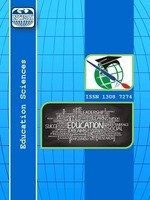EĞİTİM FAKÜLTESİ ÖĞRENCİLERİNİN ENFORMATİK BİLGİ DÜZEYLERİNİN K-MEANS ALGORİTMASI İLE GRUPLANDIRILMASI
Bu araştırmanın amacı, Akdeniz Üniversitesi Eğitim Fakültesi birinci sınıf öğrencilerinin Temel bilgisayar kullanımı bilgi düzeylerini tespit etmektir. Öğrencilerin bilgi düzeylerinin tespit edilmesi amacıyla 7 bölüm ve 56 çoktan seçmeli sorudan oluşan bir test hazırlanmıştır. Geliştirilen testin maddeleri kapsam geçerliliği için 25 Bilişim Teknoloji uzmanına gönderilmiştir. Uzmanlardan gelen geri dönütler dikkate alınarak, test yeniden gözden geçirilmiş ve bazı sorularda düzeltmeler yapılmıştır. Test toplam 173 (73 Erkek, 100 Kız) öğrenciye uygulanmıştır. Uygulama sonunda K-means kümeleme algoritması kullanılarak, elde edilen sonuçlar 5 seviyede incelendiğinde en düşük seviyedeki ortalama doğru sayısı 10 iken en yüksek seviyede ortalama doğru sayısı 44 tespit edilmiştir. Öğrencilerin en zorlandığı konuların elektronik tablolama yazılımı (%40 doğruluk oranı), internet ve bilgisayar ağları (%56 doğruluk oranı), kelime işleme yazılımı (%56 doğruluk oranı) ve Sunu hazırlama yazılımı (%57 doğruluk oranı) olduğu tespit edilmiştir. Elde edilen veriler sonucunda, öğrencilerin bilgisayar bilgi düzey yoğunluğu %57 ile orta seviyede olduğu tespit edilmiştir.
THE GROUPING OF INFORMATICS KNOWLEDGE LEVELS OF THE STUDENTS AT FACULTY OF EDUCATION USING K-MEANS ALGORITHMS
The purpose of this study is to identify the basic computer skills of the 1st year students in the faculty of education at Akdeniz University. A multiple choice test with 7 sections and 56 questions was prepared to examine students' knowledge level. The draft version of the test was sent to 25 IT experts for getting expert opinion. The test was revised based on the comments and minor modifications were done in some items. The final version of the test was administrated to 173 (73 males, 100 females) first year university students. When the results obtained in 5 level through the use of K-Means Grouping algorithm was examined, it was observed that the number of correct responses was 10 at lowest level whereas the number of correct responses was 44 at highest level. The subjects that the students had most difficulty were software of electronic tabling (40% accuracy rate), internet and computer webs (56% accuracy rate), word processing software (56% accuracy rate), and power point software (57% accuracy rate). The results also revealed that the density of students' computer knowledge level was 57% indicating low level knowledge.
